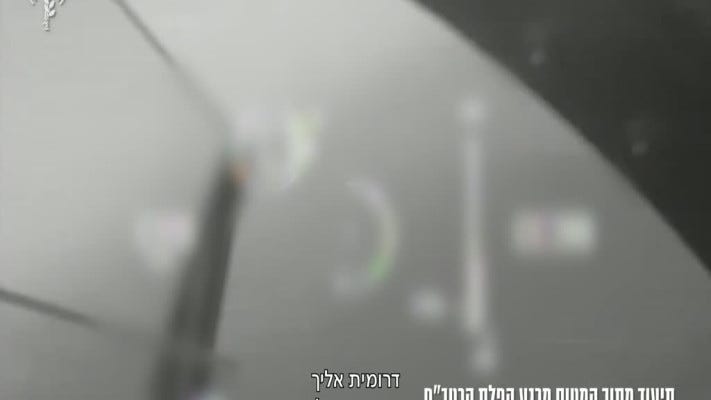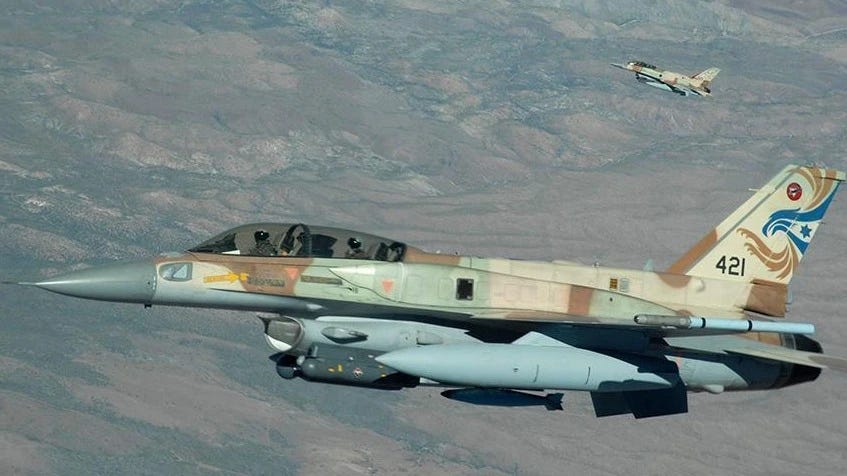Israeli Air Force reveals pilots returning from Iran attack to Israel dropped 'leftover' bombs on Gaza
I thank for sharing with me the original Hebrew article for the following, an English translation of which I am reposting below.
Army and security
The Air Force reveals for the first time: This is what the planes that will intercept the Iranian threat in Gaza did
Pilots who were busy intercepting aircraft making their way towards Israel from Iran found their planes after the operation full of weapons. Thus, the planes turned to drop the remaining armaments on Gaza.
By Avi Ashkenazi • 14:09 02/07/2025 • Maariv
The Air Force fighter jets are on their way to the waves of attacks in Iran (Photo: IDF)
A local initiative of squadron pilots of the Air Force created during 12 days Operation 'Am Kalbi' A significant offensive reality not only in Iran but also in another arena: Gaza.
The Air Force says that pilots sent on the first day of the operation in Iran to carry out a mission of Defense of the skies of Israel And to intercept missiles and missiles launched from Iran to Israel, they added ground air missiles on the planes. Each aircraft is required to perform the reconnaissance mission for a predefined period of time. At the end of the mission, the pilots turned to the control cell of the fighting in Gaza and offered to drop the remaining excess armament on targets in Gaza to help the ground forces we maneuvered in the northern Gaza Strip and in the Khan Yunis area.
The pilots' referral was welcomed and within hours the pilots' local initiative became routine. Commander of the Air Force Major General Tomer Bar, when he heard about the insight that came from below, he instructed to expand it to all squadrons and thus the Air Force intensified the waves of attacks in Gaza without adding additional forces. The IDF says that during the 12 days of fighting in Iran, Gaza suffered a wave of powerful airstrikes. When every day dozens of fighter jets that were on sky defense missions on the way to land passed over Gaza and, according to the intention of the ground forces, dropped hundreds of weapons on Hamas targets.
A local initiative of squadron pilots of the Air Force created during 12 days Operation 'Am Kalbi' A significant offensive reality not only in Iran but also in another arena: Gaza.
The Air Force says that pilots sent on the first day of the operation in Iran to carry out a mission of Defense of the skies of Israel And to intercept missiles and missiles launched from Iran to Israel, they added ground air missiles on the planes. Each aircraft is required to perform the reconnaissance mission for a predefined period of time. At the end of the mission, the pilots turned to the control cell of the fighting in Gaza and offered to drop the remaining excess armament on targets in Gaza to help the ground forces we maneuvered in the northern Gaza Strip and in the Khan Yunis area.
The pilots' referral was welcomed and within hours the pilots' local initiative became routine. Commander of the Air Force Major General Tomer Bar When he heard about the insight that came from below, he instructed to expand it to all squadrons and thus the Air Force intensified the waves of attacks in Gaza without adding additional forces. The IDF says that during the 12 days of fighting in Iran, Gaza suffered a wave of powerful airstrikes. When every day dozens of fighter jets that were on sky defense missions on the way to land passed over Gaza and, according to the intention of the ground forces, dropped hundreds of weapons on Hamas targets.
An Air Force official said that the pilots' initiative led in this case to a force multiplier of the Air Force in the various combat arenas. Beyond the large scale of the attacks, the move allowed the Air Force to make better use of its power and instead of bouncing planes off the ground for an attack policy, planes that were already in the air carried out the missions, saved a lot of resources and increased the capabilities of the Air Force, a military official explained.
Avi Ashkenazi is a military correspondent. He began his career in journalism in the 90s in the Maariv newspaper, initially as a reporter in Lebanon and the northern border and later as a transport and criminal reporter. For 11 years, Ashkenazi served as the head of Maariv's criminal desk, as well as a reporter for the American news agency AP. In the years 2014-2019, he served as a senior reporter for police and criminal affairs on the Walla website, and at the same time as a regular commentator on television and radio. In recent years he served as the spokesman for the security society of the Rishon Lezion municipality. Ashkenazi holds a master's degree in the Middle East from Tel Aviv University and serves continuously in the reserves.
The Cradle also published an article about Israel’s heinous actions based upon the same Israeli source as follows.
Israeli pilots dumped 'unused bombs' over Gaza during Iran strikes: Report
Israeli officials described the move as a resource-saving measure, but the result was intensified bombing of Gaza by jets returning from unrelated missions
News Desk • July 2, 2025
(Photo credit: Anadolu Agency)
Israeli fighter pilots returning from air defense missions during the 12-day war with Iran were routinely authorized to unload their leftover munitions on the Gaza Strip, according to a 2 July report by Maariv.
The move, initially a pilot-led initiative to “assist” Israeli ground forces in Khan Yunis and northern Gaza, was quickly expanded by Air Force Commander Tomer Bar into a daily operational policy across all squadrons.
The report outlines how, during the operation, pilots assigned to intercept missiles and drones launched from Iran were equipped not only with air-to-air missiles but also with air-to-surface munitions.
After completing their Iran-related missions, pilots contacted Gaza operation control rooms and offered to drop remaining bombs on designated targets in the enclave.
Air Force officials embraced the initiative. Within hours, the ad hoc proposal became standard practice, with squadrons instructed to coordinate with ground units before landing and to strike Gaza “Hamas targets” on their return.
Military officials described the program as a “force multiplier” that allowed the air force to expand bombing raids in Gaza without additional resources.
“Instead of bouncing planes off the ground for an attack policy, planes that were already in the air carried out the missions,” an Israeli Air Force source told Maariv. “It saved a great deal of resources and increased the Air Force’s capabilities.”
The result was what the report describes as “waves of powerful air strikes” on the strip, far removed from the Iranian front. According to the Israeli army, dozens of fighter jets participated daily, each releasing surplus munitions over the besieged enclave before landing.
While presented as a resource-efficient strategy, the practice effectively turned Gaza into a secondary front in a war that had no operational connection to the territory.
The attacks were directed based on instructions from Israeli ground forces already operating in Khan Yunis and northern Gaza, amplifying the daily bombardment of areas already under siege.
Although I continue to despair at the psychopathic evil of what the Israeli entity has and is inflicting with impunity upon the caged Palestinian population, aided and abetted by the US, UK and other entities, I will persevere with documenting these war crimes.







